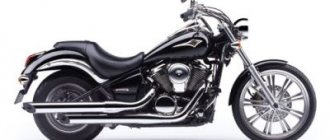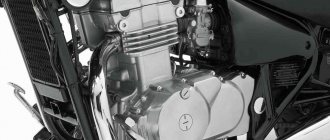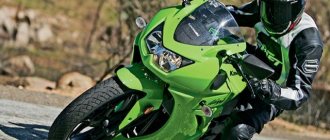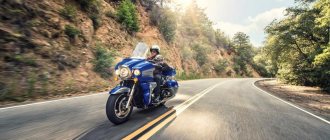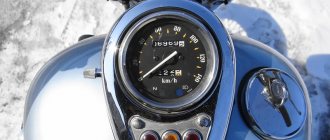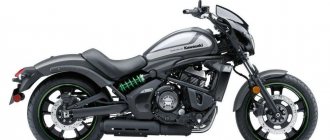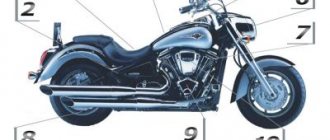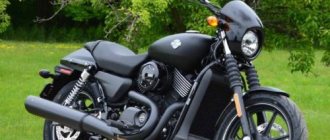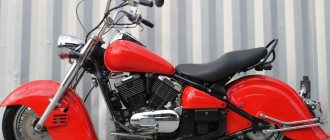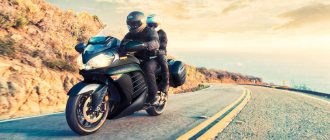Review of the Kawasaki Vulcan S (EN650S) motorcycle
It turns out that none of my non-motorcyclist friends knows what a cruiser is)) Chopper is immediately clear to everyone. Removing and installing the seat is a pain. I got used to the classics - I opened the lock with the key and that’s it. Immediately: remove the side trim, take out the key under it, use it to unscrew the screw, remove the seat. Install it in the reverse order, and by touch, install the side trim at the same time: with the pin in the hole, two guides in the slide and the lock tongue in the recess. Now I understand why cruisers don't take advantage of the space under the seat. You go over all road bumps more slowly. You can contrive and stand up on the footrests, but this will only make it worse - you will get a significant kick in the ass with the seat. This was expected and did not come as a surprise. The reverse side of the previous point is an insane thrill for the knees in the long run. If you want, straighten one leg and put it on the footrest, or if you want, both. I screwed the rings on the Ring Road for break-in - 500 km at a time is not a problem. If it weren’t for being chilled to the bone at t +7 (data from the info board above the Ring Road), I would have driven it in a day. Sixth gear is very good. 4000 on the tachometer and the speed is about 100 km/h, 6000 - 130 and the engine does not strain. 130 km/h is not a comfortable speed due to air pressure. I don’t know what makes such a difference in aerodynamics compared to the classics, but on the latter I bent over the steering wheel and everything was ok. No matter how you bend over on the neo-chopper, the helmet tries to press your nose and chin into the depths of your skull)). Do not offer wind deflectors! Only hardcore! Hardly driveable only! ))) The engine gives excellent dynamics. The long wheelbase doesn’t even hint at the front wheel coming off, but just a little bit – the rear wheel washes. The box clicks easily and naturally. The first with a slight knock and a slightly noticeable jerk. Working zone from 4000 to 9000 rpm. If you were a little lazy and didn’t put in a lower gear when accelerating/overtaking, you end up with clanging valves and shaking mirrors. Chu! I pressed the clutch, it went away, but the dynamics are not the same, it’s still better to switch to a lower gear. If you don’t forget about this, everything is great. I learned what easy handling is. I don’t understand why the W650 was so hard to corner, maybe because of the old school Firestone Deluxe tires. The Vulcan S makes it easy and effortless. At some point it starts to seem like enough is enough, this is not a sportbike. In addition to the type of tire, the size of the front disc apparently also affects it: 19 versus 18. Direct detour around the potholes is so easy that, having become impudent, I started doing it with one hand, I need to stop. )) Now I understand why all the testers praise the handling of the Vulcan S so much. The data reflecting the estimated distance to the reserve in the tank shows almost instantaneous fuel consumption. This is convenient for long-distance travel and very confusing in the city. When driving from traffic light to traffic light, it is better not to look at these numbers at all; a long scale of divisions of the fuel level in the tank is quite sufficient. For example, with constant movement, 100-110 km/h shows 350-400 km to the reserve, but if you turn it up - 150-180 km to the reserve. The sound of the standard exhaust in place and in traffic jams is absolutely nothing, there is simply no sound. It doesn't exist at speed either. But wow, how I like to suddenly add gas in 5th or 6th gear. From 4000 rpm, a rich, bass rumble bursts out of the exhaust system up to 8000, then it fades away. If I play something like Two Brothers or Arrow, it will definitely only be with a DB killer. For long-distance direct flows, my firm answer is NO! You have to get out of the habit of moving your feet in traffic jams at near-zero speed. From the classic height it is very comfortable (to move your feet), but the chopper low seating position turns you into a praying mantis))) When braking, the body weight is not all on the knees squeezing the tank, but is also distributed over the feet resting on the footpegs.
Bottom line: here I can only thank Kawasaki for a bold attempt to combine the incompatible and cram in the inconvenient, I got everything that I was missing on the W650: Ruff dynamics + comfortable, relaxed Vulcan seating = my knees no longer go numb, and even during acceleration At 650cc, sometimes you have to grab the steering wheel tighter. I am delighted!
Go to Kawasaki Vulcan S (EN650S)
Check out the test drives:
- Kawasaki Vulcan S: Comparison test with Honda CTX700
Kawasaki VN1500 Vulcan: Test drive from Motorreview
What does the president of the Moscow Vulcan Club drive? Weird question. Of course, on a Kawasaki Vulcan, and not just any ordinary one, but the largest and most luxurious one - Kawasaki VN1500 Classic Tourer . However, Ilya chose this car not only based on external appearance. According to what? Details in the owner's material.
, I had a smaller “Vulcan” - Kawasaki VN800 Classic A. I liked everything about it (I drove almost 30,000 km), with the exception, perhaps, of one thing - it’s not very comfortable to travel long distances. After “hundreds” the engine is rather weak, and its modest weight does not allow you to feel confident on open highways. After returning from a trip to Europe again, I decided to find a replacement for him. I admit, parting with the “eight hundredth” was very difficult.
Oh, how many kilometers we have lived together, how much tuning and useful improvements have been made! Became a relative, a member of the family! Therefore, I decided for myself - if I’m going to give it away, then it should be in good hands. For example, to a friend. And so it happened.
Why Kawasaki VN1500 Classic Tourer ? It's just hi-end in the Vulcan family. Not only is this a customized “tourist”, but it also comes with a full set of factory tuning. There is no need to invent anything or look for anything in catalogues—everything is included from the very beginning. And the fuel-injected engine, alloy wheels, windshield, plastic lockable cases and reinforced brakes are very useful.
In general, when I first saw this abundance on one motorcycle, I immediately understood - I just want it! This would take you to the end of the world. Apparently this is fate. Because I sold my “old” one and bought a new Vulcan almost on the same day. Then the enthusiastic jitters from the new purchase ended, and surprises began. The first day I just spat! Lord, what have I done! I sold the good girl, and in return I got a hulking hulk!
The grinding has begun. We got used to each other, changed ourselves, got used to it. Gradually, along with negative qualities, I began to notice clearly positive ones. What I didn’t like, I tried to improve. The first thing I did was change the steering columns. Your humble servant does not boast a gigantic height, so I had to lower the steering wheel slightly - the 4-inch struts are slightly bent towards the pilot. It immediately became easier to steer, especially at low speeds when turning. The second replacement is related to glass. Although the main “burdock” has five adjustment positions, it is clearly not intended for short drivers. After 120 km/h, a turbulent flow arose right in the area of the helmet - my head began to shake so that “Mom, don’t worry.” The problem was solved by enlarging the lower glass deflectors.
The more I drove it, the more I fell in love. I already liked everything: the huge mass (the wind is on our side!), the huge silhouette (the cars scatter in a scattering manner), the inertia (as if giving the pilot time to think about the maneuver), and, of course, the spaciousness. Not only is it easy to load with everything you need for a trip, but two people can easily travel on it. Of course, it loses in dynamics, but on the track you feel more confident. It “stands” on the trajectory like a glove, rides as if on rails. The chassis turned out to be very rigid. The device feels very comfortable even at high speed. If on the “eight hundred” my wife and I accelerated to 190 km/h and froze in horror, then on the “tourer” even 180 km/h - the flight was normal.
But let's get back to the main thing. The real revelation for me was the Tourer's low-speed handling. The weight distribution of the car is simply excellent; when you are moving in a traffic jam, you can even freeze in place for a few seconds and continue on your way again, putting it in turns like a tumbler. True, we must not forget about uniform loading of the cases. Their mass affects handling. By the way, about trunks. We still have to come up with something better! Firstly, they are locked, secondly, they do not get wet and, finally, allow you to place everything you need there, for example, musical equipment. Which is exactly what I did.
I would also like to note the ergonomics. The pilot behind the wheel (already modified for himself) is very comfortable. The wide platforms for the feet, the gear shift lever with two paws, and the thick steering wheel handles are very comfortable. Vibrations are kept to a minimum. Only on the steering wheel at a certain speed (110-120 km/h) there are “spikes”. There are other fly in the ointment. The “tidy” on the gas tank as standard is practically unreadable during the day, and at night it generates a whole range of multi-colored lights on the inside of the windshield.
The solution to this problem is simple: you need to install a visor on the outer part of the speedometer dial. By the way, if you are going to ride the Kawasaki VN1500 Classic Tourer with an integral helmet, then in order to see the readings on the instrument panel, you will have to lower your head down. Otherwise, the “jaw” interferes with visibility. Another nuance with mirrors. No, they have good visibility and have no blind spots, but they are very difficult to set up.
To set the required angle, you first need to remove the rubber seal around the perimeter, then the mirror, and fasten the bolts inside the housing. With one of these settings, I cracked the left mirror. I would also like to note that the position of the passenger footrests is not entirely correct. They are designed so that the second number is as comfortable as possible. But the driver pays for this comfort. When starting off, or in maneuvers when you move your feet, the boot can get into the gap between the platforms and get stuck there. It's an unpleasant feeling, I admit.
I would also advise you to park this Kawasaki VN1500 Classic Tourer only with the rear wheel facing the curb. There was a case where, with my own efforts, I was unable to reverse this 350-kilogram colossus up an easy hill from the parking lot. These attempts looked very comical.
The chassis, as I already said, is rigid and durable. And a lot of credit for this goes to the pendants. The front fork perfectly “swallows” the imperfections of the track and does not suffer at all from the “dive effect” that is so typical of large cruisers. The rear shock absorbers are the height of perfection. They can be adjusted right on the road to suit any type of road surface and any vehicle load. After all, the shock absorbers are adjustable for spring preload and inflation fittings up to 2 atm. air.
Now about tuning. Although I consoled myself with the thought that there was nothing to bring to mind here, but... I started with the trunks. You throw your leg over the motorcycle when you get off or on, and you scratch the plastic. To prevent this, I installed chrome grilles on top. This time. Two - arches for the cases, so as not to scratch when tilting or falling. Then the same chrome “kenguryatniki” on the front and rear fenders. Cute!
Now it's time for the seat - a lower Mustang with a backrest. But, I admit, there was a mistake (it’s inconvenient to drive such a colossus, especially with a wide steering wheel from somewhere below, and in a brace), and then I returned everything back. I installed “music”, all sorts of overlays, things, visors. But even with the realization that the Kawasaki VN1500 Classic Tourer was becoming more and more elegant with every detail, I tried to dose out the infusions. Stretched out the pleasure. The main thing in our business is the process... Probably the most useful of the improvements was the third top removable case (what you need for traveling) with a trunk, the installation of reinforced hoses and a reinforced clutch. Although now working with the left lever in traffic jams has become somewhat more tiring.
Three seasons behind us, and some conclusions have already formed in my head. What should you buy first? 90-degree adapter for wheel inflation. The fact is that the valves are located very inconveniently. At the front, access is limited by wide brake discs, and at the rear there are mufflers, arches and panniers. The second feature is that the motorcycle is very difficult to repair. To get to any detail, you need to scatter half the device. As mechanics say about the Kawasaki VN1500 Classic Tourer , it’s a cool motorcycle, but there are so many of them! However, it is unlikely that users of such a model will do anything themselves. It is also worth paying attention to the following feature.
The exhaust pipes here are not chrome-plated, but covered with chrome plates. The latter are attached using clamps. So, don’t be surprised if, once you remove this piece of hardware, you won’t be able to put it back - the clamps are practically disposable. However, you can treat them by bending back the dented area with the notch. It is very difficult to maintain the front “telescope”. To simply change the oil, you need to remove the feathers and drain the liquid through the top. And to do this, you need to dismantle a whole bunch of everything. It's strange why there are no drain fittings at the bottom, like on the Honda? What else? The Kawasaki VN1500 Classic Tourer is sensitive to tire wear. As soon as the tire becomes a little bald, the vehicle begins to turn its rear wheel and wobble at high speed. And finally, the last thing is low ground clearance. Most motorcycle curbs are insurmountable.
Now about the advantages. The neck of the tank is conveniently made - you can refuel without straining until it is full at the cut-off point. By the way, with its considerable weight and engine capacity, the cruiser “eats” very modestly - 5-7 liters per “hundred”. It was nice to find self-canceling turn signals. Not every “Japanese” flaunts this option. The glove compartment for tools is very rationally designed. It is noteworthy that despite the above-mentioned difficulty in repair and maintenance, the model is extremely convenient.
The spark plugs are unscrewed “one-two-three”, the air filter is even faster, the oil filter is located at the bottom in a recess, which eliminates accidental damage. The on-board system tests numerous system sensors each time and signals failures if something happens. And the injector itself is a simpler thing than the same carburetor. Here, if something is clogged, it is immediately clear what exactly it is. True, clogged injectors are a common occurrence on our gasoline. Typically, the spark plugs fail within 2000-3000 km.
Do you think that thin side arches are just decoration? You are wrong! They not only give the appearance a special charm, but protect the bodies (motorcycle and pilot) from sliding on the asphalt. I really didn’t think that a collision with a dog could result in such a minimum of destruction - I just chipped off a couple of millimeters of metal on the arches. The device simply lay down on them and in this position plowed several meters of the road surface. The driver escaped with a slight fright. Even the panniers were not scratched!
So this “volcano” gave me only positive impressions. On the track he is the leader.
Go to the Kawasaki VN 1500 Vulcan
- Read review of Kawasaki VN 1500 Vulcan
Check out the test drives:
- Yamaha XV1600A: Comparative test drive with Kawasaki VN1500 Vulcan Drifter
I registered here just now, looked and saw almost nothing on the Kawasaki VN750, although there are 13 of them in the garages here. We need to fix this. So in May 2018 there was a choice between a Viraga 750 from 1987 with a confirmed mileage of 3,500 km and a VN750 from 2005 with a mileage of about 25,000 miles. The main problem with Viraga is that its design makes my eyes itch, and the year it was produced already looks like a museum. The choice fell on Kava. From the place of purchase, I drove it home for a long time, it did not steer at all, especially in traffic jams and in the aisles. I had to swing my fins like a first-timer. As it turned out later, I was driving on a completely flat rear tire and with a crooked steering wheel. But more on that below.
So I just drove to the house, my back is wet from such driving, Kawasaki VN750, 2005, 66 hp, American, I think, I’m the third owner. What I liked about this bike: 1. Tachometer, fuel level, emergency lights 2. Of course, the dynamics, after Shame, what you need 4. Cardan. Yes, down with the brushes and kerosene 5. Central footrest 6. The battery is directly under the seat, and not below or on the side where you can’t crawl 7. Footrests. Not skis yet, but no longer poles 8. Adjustable rear shock absorbers with pumping capability.
Didn't like: 1. The quality of the engine coating. I don’t know if it’s the paint or the anodizing, but it’s very peeling in places 2. The frame and the rest are better painted, but not in comparison with the Honda. Paint directly onto metal, without primer. 3. Rear glove compartment in the back of the seat. The design and execution are a bummer, the plastic rattles 4. The appearance is IMHO much better than the Viraga, but the fact that it comes from the 80s is obvious from all the cracks. Especially the arches to which the rear shock absorbers are attached, like on the Intruder. 5. The starter is right behind the front wheel, but this was the case with many Japs of that time
Now about the jambs inherited from previous owners. 1. The engine was leaking and the seals on the valves clearly needed to be replaced. 2. The rear tires, which were completely trashed, did not hold pressure, repairs did not help, and therefore I drove it purely on the cord several times. And somehow it gave 160 on the highway. Dementia, laziness and lack of money. 3. With this motorcycle, I hated decorations like a tie and a loaf. Especially cheap ones. The first one scratched the entire tank. The second front wing 4. The mot was attached on both sides. On the left is a box, and on the right is asphalt. As a result, the left brake disc is bent, the left brake blade, the steering wheel has abrasions on the air filter housing and the exhaust. As a result
That's basically all. At least I don't remember anything else yet. In the first season, I replaced the rear tires with Mishka Commander 3. And wider, the extreme size that fits into the frame. Native 150/90-15, installed 170/80-15. When you put it up, put it down, otherwise it won’t fit. Well, immediately throw off the pipes and jet thrust. Without this, you cannot unscrew the rear axle bolt. Before it was almost zero. And my season was short, I had seven broken ribs. A month and a half on sick leave. But not on a motorbike, and that’s good. Blue is evil.
Last exit before the sick leave, 750th Intruder on the left.
I have a little planned for the off-season. Just replace the valve seals. What can I tell you? I threw the engine into one snout in a day. I don’t particularly remember any ambushes there.
I ordered head gaskets and seals from Megazip. The price of the gaskets was an unpleasant surprise. About 2500 per piece, plus shipping. I removed the heads, laid them out, signed them, cleaned them and started grinding the valves.
The quality of the photo is jackal, but atmospheric. I poked it from my insta, I don’t know how to get my own photo out of there.
I threw the hydraulic compensators into kerosene, according to the manual. Yes, regarding the disassembly and reassembly of the engine, I found a dude on YouTube, he does it on camera and, although he speaks in English, everything is shown in detail and everything is clear. Fortunately, it would have been necessary to replace the timing chains even then, but money is money. It was hard for them. That’s why I ended up on pads again this year. But that's another story.
PS: Throw away this garbage and others like it, and turn off the head and pipe on the carb. Unless of course you are an environmentalist.
History of changes
The bike underwent a number of changes throughout the production period:
- 1984 – beginning, model called VN 700;
- 1985 – the name changes to VN 750;
- 1995 - VN 800 of the same series was created, but it could not replace the 750;
- 1996 is the last year for the 750 and 800 models.
This motorcycle is a great example of how design inspiration can be embodied in a piece of metal. Powerful and strong, the VN 750 is ready for testing not only on the road, but also in moderate off-road conditions. However, we should not forget that the cruiser, no matter how powerful it is, is clearly not designed to “collect” all the surrounding hills and bumps.
Moto-Links
“Vulcan Club” is a public organization that unites people who consider motorcycles and riding them a part of their life and for whom the Club is an opportunity to make friends and partners who are also passionate about motorcycles. Over our seven-year history, we have accumulated a wealth of experience in driving in convoys around the city and over long distances, visited many interesting places and events, and most importantly, made many friends from different cities and countries.
The Moscow Vulcan Club was organized in September 1999 and was a virtual association of owners of Kawasaki Vulcan motorcycles. The first club meeting took place on October 17, received international status and began to be considered the Birthday of the Club. During the existence of the MVK, we held the first Toy Run and Poker Run in Moscow and organized a club trip to Amsterdam, where we met with representatives of the Dutch (VOCN) and English (VRA UK) Vulcan Clubs. We are proud that our patches, T-shirts and badges are worn in Germany, Belgium, Holland, England, America, Sweden and Spain. In Russia, the Club's patch can be seen in St. Petersburg and Voronezh. Vulcan Club is known all over the world among owners of Kawasaki Vulcan motorcycles.
Since August 29, 2001, the virtual Moscow Vulcan Club ceased to exist: in its place, the Regional Public Organization of Motorcyclists “Vulcan Club” officially registered with the Ministry of Justice appeared. The rules for joining the Club have become a little more complicated, membership and entrance fees have appeared, rules of conduct, rights and obligations of Club members that must be adhered to.
In life, everything flows and changes, and the club changes with us in order to more fully meet our wishes. Since 2005, Vulcan Club has ceased to be a vintage club. Now our doors are open to owners of all brands of motorcycles, however, at the same time, the rules for joining the club and the requirements for club members have changed.
At the general meeting of the Club on October 28, 2006, the Moscow Vulcan Club (RC), organized in 1999 as a club of Kawasaki Vulcan motorcycle owners, changed its name and emblem. This decision was made by us after much debate and is associated with the growth and expansion of the club.
We still remain an independent motorcycle club, with the only difference that we have moved away from the principles of branding (only a candidate who owns a Kawasaki Vulcan motorcycle could be a member of the club) as one of the main requirements for membership in the club. Otherwise, we remained true to our traditions and principles, as well as our friendship with many motorcycle clubs in the territory of the former USSR, in the countries of the former socialist camp and in the current European Union.
Best regards Vulcans MCC
Dimensions and weight
The wheelbase of this metal horse reaches 1585 millimeters. It is not very wide – only 860 millimeters. The model is quite high: the overall height is 1235 millimeters, and at the saddle – 750 millimeters. The length of the car is 2310 millimeters, and its weight is 241 kilograms. But all these respectable dimensions do not prevent the motorcycle from reaching speeds of up to 180 kilometers per hour, which is a record figure for a cruiser.
Chassis and brakes
The tubular steel body pleases with its daring and at the same time discreet beauty: the design is not too flashy, but it cannot be called modest either. All elements are clearly visible and emphasized, and the characteristic shape of the frame catches the eye.
The model's suspension is simple: a pendulum version with a stroke of 90 millimeters is installed at the rear and has a pair of shock absorbers; in front there is a telescopic fork with dimensions of 38 millimeters, with a stroke of 150 millimeters. The wheels of the model are larger than the average, but within the framework of the classics. The wheels are alloy, which makes the motorcycle more modern in appearance.
A massive steering wheel with stylish mirrors makes it easy to control this furious mechanism. The size of the handlebars is proportional to the dimensions of the bike, and the diameter of the handles will be comfortable for most people.
The rear brake is very standard and is a drum option. But in front there is something special - 2 discs, each with a diameter of 226 millimeters; they are equipped with single-piston calipers.

